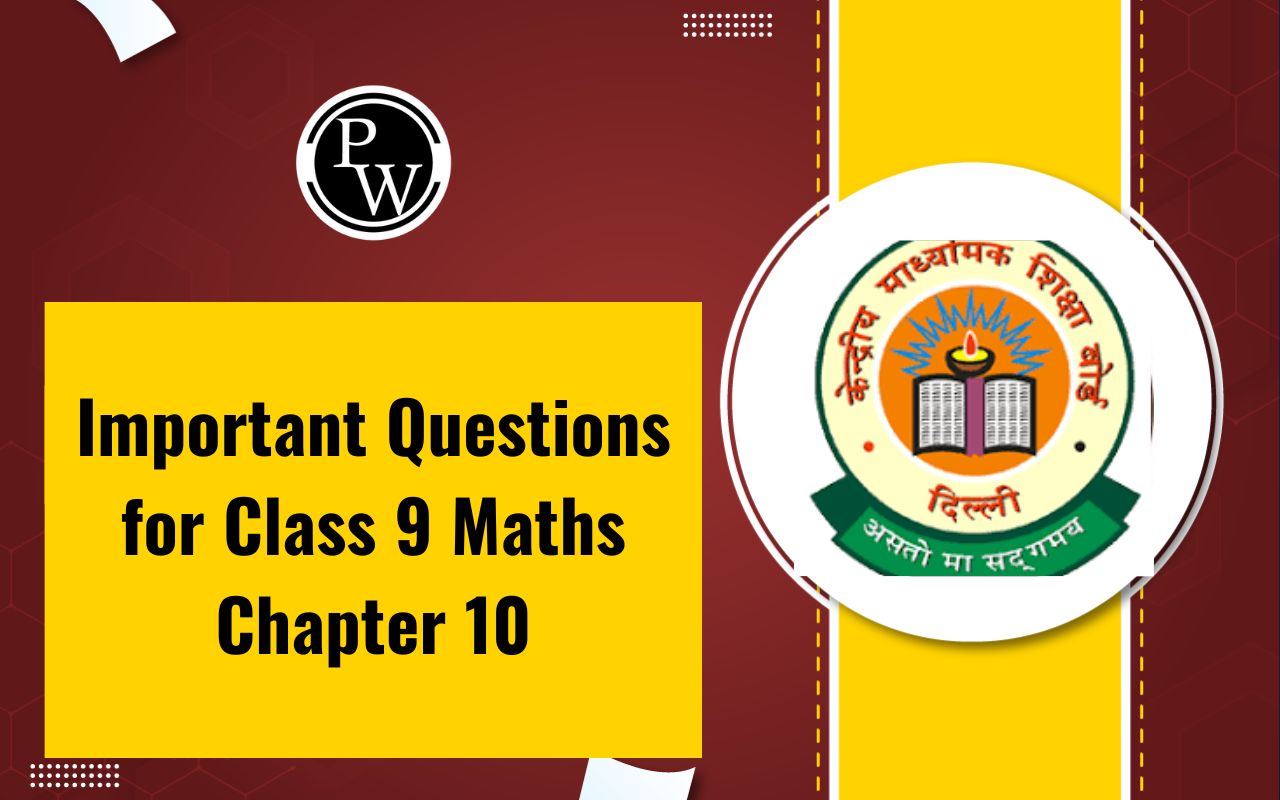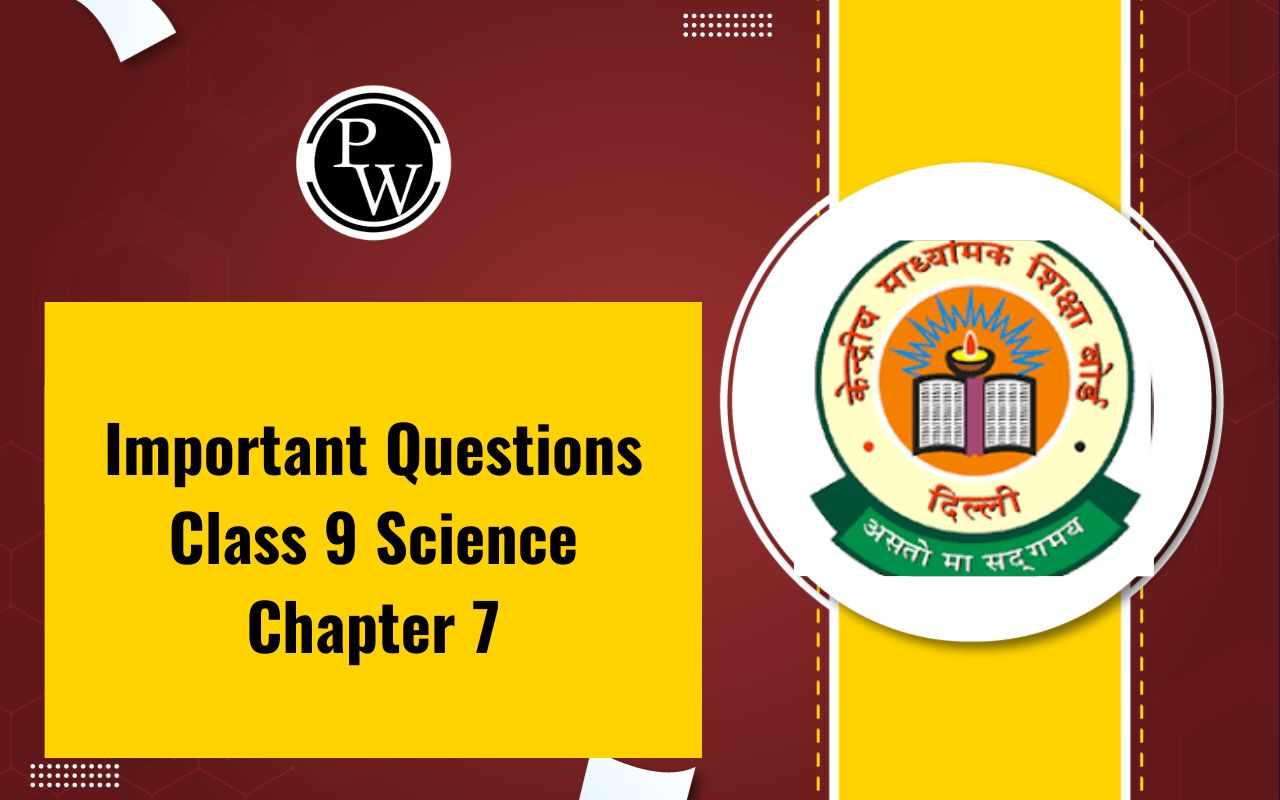

Important Questions for Class 9 Maths Chapter 10: Here are some important questions for Class 9 Maths Chapter 10 Circles created to help students grasp key concepts. This chapter covers essential topics such as the definition of a circle, radius, diameter, chord, arc and sector.
Students should focus on understanding the properties of circles, including the relationship between angles and chords, as well as theorems related to tangents and secants. Practicing these important questions will enhance problem-solving skills and boost confidence for exams. By mastering the concepts in this chapter students can build a strong foundation for more advanced studies in geometry.Important Questions for Class 9 Maths Chapter 10 Overview
The important questions for Class 9 Maths Chapter 10 Circles are created by subject experts of Physics Wallah to help students understand the topic better. By practicing these questions, students can improve their understanding and problem-solving skills, which will help them do well in their exams.Important Questions for Class 9 Maths Chapter 10 PDF
You can access the Important Questions for Class 9 Maths Chapter 10 in PDF format by clicking the link below. This PDF contains a set of important questions designed to enhance your understanding of circles and their properties, making it a valuable resource for your exam preparation.Download Important Questions for Class 9 Maths Chapter 10 PDF
Important Questions Class 9 Maths Chapter 10 Circles
Below we have provided Important Questions Class 9 Maths Chapter 10 Circles-Question 1:
Bisectors of angles A, B and C of a triangle ABC intersect its circumcircle at D, E and F respectively. Prove that the angles of the triangle DEF are 90° – (½)A, 90° – (½)B and 90° – (½)C.
Solution:
Here, ABC is inscribed in a circle with center O and the bisectors of ∠A, ∠B and ∠C intersect the circumcircle at D, E and F respectively. Now, join DE, EF and FD As angles in the same segment are equal, so, ∠FDA = ∠FCA ————-(i) ∠FDA = ∠EBA ————-(i) Adding equations (i) and (ii) we have, ∠FDA + ∠EDA = ∠FCA + ∠EBA Or, ∠FDE = ∠FCA + ∠EBA = (½)∠C + (½)∠B We know, ∠A + ∠B + ∠C = 180° So, ∠FDE = (½)[∠C + ∠B] = (½)[180° – ∠A] ⇒ ∠FDE = [90 – (∠A/2)] In a similar way, ∠FED = [90 – (∠B/2)] And, ∠EFD = [90 – (∠C/2)]Question 2:
In any triangle ABC, if the angle bisector of ∠A and perpendicular bisector of BC intersect, prove that they intersect on the circumcircle of the triangle ABC.
Solution:
Given: In ∆ABC, AD is the angle bisector of ∠A and OD is the perpendicular bisector of BC, intersecting each other at point D. To Prove: D lies on the circle Construction: Join OB and OC Proof: BC is a chord of the circle. The perpendicular bisector will pass through centre O of the circumcircle. ∴ OE ⊥ BC & E is the midpoint of BC Chord BC subtends twice the angle at the centre, as compared to any other point. BC subtends ∠BAC on the circle & BC subtends ∠BOC on the centre ∴ ∠BAC = 1/2 ∠ BOC In ∆ BOE and ∆COE, BE = CE (OD bisects BC) ∠BEO = ∠CEO (Both 90°, as OD ⊥ BC) OE = OE (Common) ∴ ∆BOE ≅ ∆COE (SAS Congruence rule) ∴ ∠BOE = ∠COE (CPCT) Now, ∠BOC = ∠BOE + ∠COE ∠BOC = ∠BOE + ∠BOE ∠BOC = 2 ∠BOE …(2) AD is angle bisector of ∠A ∴ ∠BAC = 2∠BAD From (1) ∠BAC = 1/2 ∠BOC 2 ∠BAD = 1/2 (2∠BOE) 2 ∠BAD = ∠BOE ∠BAD = 1/2 ∠BOE BD subtends ∠BOE at centre and half of its angle at Point A. Hence, BD must be a chord. ∴ D lies on the circle.Question 3:
Prove that the circle drawn with any side of a rhombus as diameter passes through the point of intersection of its diagonals.
Solution:
To prove: A circle drawn with Q as centre, will pass through A, B and O (i.e. QA = QB = QO) Since all sides of a rhombus are equal, AB = DC Now, multiply (½) on both sides (½)AB = (½)DC So, AQ = DP ⇒ BQ = DP Since Q is the midpoint of AB, AQ= BQ Similarly, RA = SB Again, as PQ is drawn parallel to AD, RA = QO Now, as AQ = BQ and RA = QO we have, QA = QB = QO (hence proved).Question 4:
Two chords AB and CD of lengths 5 cm and 11 cm respectively of a circle are parallel to each other and are on opposite sides of its centre. If the distance between AB and CD is 6, find the radius of the circle.
Solution:
Here, OM ⊥ AB and ON ⊥ CD. is drawn and OB and OD are joined. As we know, AB bisects BM as the perpendicular from the centre bisects the chord. Since AB = 5 so, BM = AB/2 Similarly, ND = CD/2 = 11/2 Now, let ON be x. So, OM = 6− x. Consider ΔMOB, OB 2 = OM 2 + MB 2 Or, OB 2 = 36 + x 2 – 12x + 25/4 ……(1) Consider ΔNOD, OD 2 = ON 2 + ND 2 Or, OD 2 = x 2 +121/4 ……….(2) We know, OB = OD (radii) From eq. (1) and eq. (2) we have; 36 + x 2 -12x + 25/4 = x 2 + 121/4 12x = 36 + 25/4 – 121/4 12x = (144 + 25 -121)/4 12x = 48/4 = 12 x = 1 Now, from eq. (2) we have, OD2 = 11 + (121/4) Or OD = (5/2) × √5Question 5:
If circles are drawn taking two sides of a triangle as diameters, prove that the point of intersection of these circles lies on the third side.
Solution:
First, draw a triangle ABC and then two circles having a diameter as AB and AC respectively. We will have to now prove that D lies on BC and BDC is a straight line. Proof: As we know, angle in the semi-circle are equal So, ∠ADB = ∠ADC = 90° Hence, ∠ADB + ∠ADC = 180° ∴ ∠BDC is a straight line. So, it can be said that D lies on the line BC.Question 6:
If the non-parallel sides of a trapezium are equal, prove that it is cyclic.
Solution:
Construction-Consider a trapezium ABCD with AB||CD and BC = AD. Draw AM ⊥CD and BN ⊥ CD In ∆AMD and ∆BNC; AD = BC (Given) ∠AMD = ∠BNC (90°) AM =BN (perpendiculars between parallel lines) ∆AMD = ∆BNC (By RHS congruency) ∆ADC = ∆BCD (By CPCT rule) …….(i) ∠BAD and ∠ADC are on the same side of transversal AD. ∠BAD + ∠ADC = 180° ……(ii) ∠BAD + ∠BCD = 180° (by equation (i)) Since, the opposite angles are supplementary, therefore, ABCD is a cyclic quadrilateral.Question 7:
ABCD is a cyclic quadrilateral whose diagonals intersect at a point E. If ∠DBC = 70°, ∠BAC is 30°, find ∠BCD. Further, if AB = BC, find ∠ECD.
Solution:
Consider the chord CD, As we know, angles in the same segment are equal. So, ∠CBD = ∠CAD ∴ ∠CAD = 70° Now, ∠BAD will be equal to the sum of angles BAC and CAD. So, ∠BAD = ∠BAC + ∠CAD = 30° + 70° ∴ ∠BAD = 100° As we know, the opposite angles of a cyclic quadrilateral sum up to 180 degrees. So, ∠BCD + ∠BAD = 180° Since, ∠BAD = 100° So, ∠BCD = 80° Now consider the ΔABC. Here, it is given that AB = BC Also, ∠BCA = ∠CAB (Angles opposite to equal sides of a triangle) ∠BCA = 30° also, ∠BCD = 80° ∠BCA + ∠ACD = 80° So, ∠ACD = 50° and, ∠ECD = 50°Question 8:
In Figure, ∠ABC = 69°, ∠ ACB = 31°, find ∠BDC.
Solution:
As we know, angles in the segment of the circle are equal so, ∠BAC = ∠BDC Now in the In ΔABC, sum of all the interior angles will be 180° So, ∠ABC + ∠BAC + ∠ACB = 180° Now, by putting the values, ∠BAC = 180° – 69° – 31° So, ∠BAC = 80°Question 9:
In Figure, ∠PQR = 100°, where P, Q and R are points on a circle with centre O. Find ∠OPR.
Solution:
Since angle which is subtended by an arc at the centre of the circle is double the angle subtended by that arc at any point on the remaining part of the circle. So, the reflex ∠POR = 2 × ∠PQR We know the values of angle PQR as 100° So, ∠POR = 2 × 100° = 200° ∴ ∠POR = 360° – 200° = 160° Now, in ΔOPR, OP and OR are the radii of the circle So, OP = OR Also, ∠OPR = ∠ORP Now, we know sum of the angles in a triangle is equal to 180 degrees So, ∠POR + ∠OPR + ∠ORP = 180° ⇒ ∠OPR + ∠OPR = 180° – 160° As ∠OPR = ∠ORP ⇒ 2∠OPR = 20° Thus, ∠OPR = 10°Question 10:
A circular park of radius 20m is situated in a colony. Three boys Ankur, Syed and David are sitting at equal distance on its boundary each having a toy telephone in his hands to talk each other. Find the length of the string of each phone.
Solution:
Here the positions of Ankur, Syed and David are represented as A, B and C respectively. Since they are sitting at equal distances, the triangle ABC will form an equilateral triangle. AD ⊥ BC is drawn. Now, AD is median of ΔABC and it passes through the centre O. Also, O is the centroid of the ΔABC. OA is the radius of the triangle. OA = 2/3 AD Let the side of a triangle a metres then BD = a/2 m. Applying Pythagoras theorem in ΔABD, AB 2 = BD 2 + AD 2 ⇒ AD 2 = AB 2 – BD 2 ⇒ AD 2 = a 2 – (a/2) 2 ⇒ AD 2 = 3a2/4 ⇒ AD = √3a/2 OA = 2/3 AD ⇒ 20 m = 2/3 × √3a/2 ⇒ a = 20√3 m So, the length of the string of the toy is 20√3 m.Question 11:
If two equal chords of a circle intersect within the circle, prove that the line joining the point of intersection to the centre makes equal angles with the chords.
Solution:
From the question we have the following conditions: (i) AB and CD are 2 chords which are intersecting at point E. (ii) PQ is the diameter of the circle. (iii) AB = CD. Now, we will have to prove that ∠BEQ = ∠CEQ For this, the following construction has to be done: Construction: Draw two perpendiculars are drawn as OM ⊥ AB and ON ⊥ CD. Now, join OE. The constructed diagram will look as follows: Now, consider the triangles ΔOEM and ΔOEN. Here, (i) OM = ON [Since the equal chords are always equidistant from the centre] (ii) OE = OE [It is the common side] (iii) ∠OME = ∠ONE [These are the perpendiculars] So, by RHS similarity criterion, ΔOEM ≅ ΔOEN. Hence, by CPCT rule, ∠MEO = ∠NEO ∴ ∠BEQ = ∠CEQ (Hence proved).Question 12:
If two circles intersect at two points, prove that their centres lie on the perpendicular bisector of the common chord.
Solution:
It is given that two circles intersect each other at P and Q. To prove: OO’ is a perpendicular bisector of PQ. Proof: Triangle ΔPOO’ and ΔQOO’ are similar by SSS congruency since OP = OQ and O’P = O’Q (Since they are also the radii) OO’ = OO’ (It is the common side) So, It can be said that ΔPOO’ ≅ ΔQOO’ ∴ ∠POO’ = ∠QOO’ — (i) Even triangles ΔPOR and ΔQOR are similar by SAS congruency as OP = OQ (Radii) ∠POR = ∠QOR (As ∠POO’ = ∠QOO’) OR = OR (Common arm) So, ΔPOR ≅ ΔQOR ∴ ∠PRO = ∠QRO Also, As we know, ∠PRO + ∠QRO = 180° Hence, ∠PRO = ∠QRO = 180°/2 = 90° So, OO’ is the perpendicular bisector of PQ.Question 13:
Prove that if chords of congruent circles subtend equal angles at their centres, then the chords are equal.
Solution:
Here, it is given that ∠AOB = ∠COD i.e. they are equal angles. Now, we will have to prove that the line segments AB and CD are equal i.e. AB = CD. Proof: In triangles AOB and COD, ∠AOB = ∠COD (as given in the question) OA = OC and OB = OD ((these are the radii of the circle) So, by SAS congruency, ΔAOB ≅ ΔCOD. ∴ By the rule of CPCT, AB = CD. (Hence proved).Benefits of Practicicng Important Questions for Class 9 Maths Chapter 10
Important Questions for Class 9 Maths Chapter 10 FAQs
What is a circle?
What are the key components of a circle?
What is a chord?
What is the difference between a tangent and a secant?












